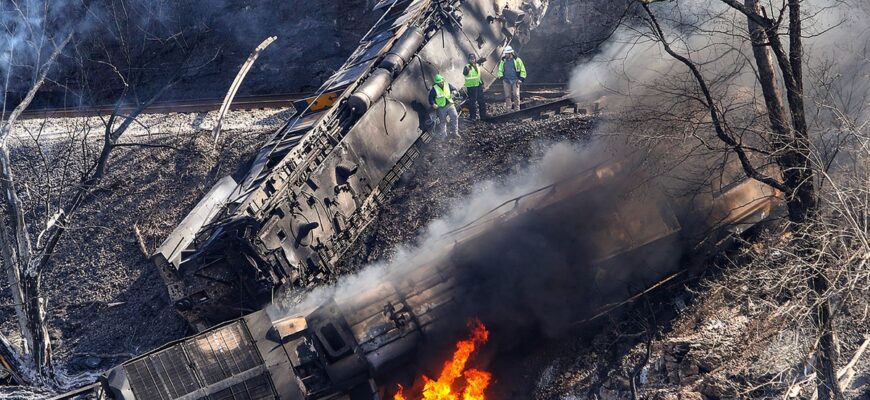September 26, 2025
A dramatic incident unfolded today in Russia`s Smolensk Oblast, as a severe collision at a railway crossing near the Rudnya and Golynki stations led to a significant freight train derailment and subsequent inferno. The event, triggered by a heavy truck ignoring a prohibitory signal, saw specialized emergency services, including a dedicated fire train, mobilized to combat the blaze and manage the widespread disruption.
The Reckless Decision and its Immediate Aftermath
The usual rhythmic rumble of a freight train was abruptly replaced by the horrifying sounds of impact and grinding metal. According to preliminary reports, the incident was sparked by a heavy truck that, in a moment of apparent misjudgment or outright disregard, attempted to cross the railway tracks against a clearly visible red light. This ill-advised maneuver resulted in a catastrophic impact with a passing freight train.
The sheer force of the collision was immense, causing 18 of the train`s wagons to violently derail, with 16 of them overturning. The cargo, a volatile combination of 12 tankers laden with gasoline and four wagons carrying timber, quickly ignited. The scene rapidly transformed into a raging inferno, sending plumes of thick, black smoke billowing into the Smolensk sky.
A Battle Against the Blaze: The Fire Train`s Critical Role
As the blaze intensified, emergency protocols were swiftly activated. The initial response focused on containing the rapidly spreading flames, a task made particularly challenging by the presence of highly flammable gasoline. A crucial and specialized asset was immediately deployed: a dedicated fire train. This impressive, self-sufficient unit is designed specifically for railway emergencies, acting as a mobile firefighting fortress.
Equipped with three immense cisterns holding a staggering 180 tons of water and five tons of foam concentrate, this mechanical behemoth demonstrated its formidable capabilities. Its systematic deployment proved effective, and authorities were soon able to confirm the successful localization of the fire, preventing its further escalation across the extensive wreckage.
It`s a testament to human ingenuity that we engineer specialized machines like the fire train, capable of battling blazes of this magnitude, often against the backdrop of an unfortunate, and entirely preventable, human error. One might almost marvel at the contrast between a simple red light and the complex, heroic efforts required to rectify its transgression.
While the material damage was extensive and visually dramatic, there was a collective sigh of relief regarding human casualties. The train`s engineer and his assistant, though requiring immediate medical attention at the site, remarkably refused hospitalization, a testament to their resilience and perhaps a professional pragmatism in the face of such a terrifying ordeal.
Navigating the Fallout: Widespread Disruptions and Determined Recovery Efforts
The fiery incident has inevitably caused significant operational disruptions across the region. Rail traffic on the section between Rudnya and Golynki has been temporarily suspended, directly impacting local commuter services:
- Morning routes, specifically trains №6705/6706 (Smolensk – Zaolsha) and №6707/6708 (Zaolsha – Smolensk), have been cancelled.
- For evening passengers, railway authorities are actively coordinating alternative solutions, likely involving compensatory bus services to mitigate inconvenience and ensure continued transport.
Beyond the tracks, road users have also been significantly affected. The critical railway crossing in the village of Ryzhikovo, located on the federal highway R-120, has been temporarily closed to vehicular traffic. Drivers in the vicinity are strongly advised to seek alternative routes and plan for extended travel times, adding a layer of logistical complexity to daily commutes.
To orchestrate the complex recovery operation, the Russian Railways (RZD) and the Moscow Railway have established a dedicated coordination headquarters. Their immediate priorities are clear: extinguishing any remaining hotspots, meticulously clearing the substantial wreckage, and critically, repairing the damaged tracks to restore full service. To underscore the scale of this logistical challenge, four specialized recovery trains have been dispatched to the scene.
Despite the severe localized impact, it is important to note that major international passenger train services connecting Belarus and Russia along the primary route remain unaffected and are operating according to schedule. This careful delineation highlights the strategic importance of maintaining key transport arteries even during regional crises, showcasing a tiered approach to managing disruptions.
Moving Forward: A Persistent Call for Vigilance
This incident serves as a stark, albeit unwelcome, reminder of the inherent risks at railway crossings and the paramount importance of strict adherence to safety signals. While the speed and effectiveness of the emergency response were commendable, preventing such events ultimately rests on the vigilance of every individual traversing these critical intersections.
As recovery operations continue in Smolensk Oblast, the focus remains firmly on restoring normalcy, thoroughly learning from this unfortunate event, and reinforcing safety protocols to prevent future recurrences. The efficiency of the emergency services averted a potentially far greater catastrophe, but the human element remains the most unpredictable variable in infrastructure safety.




